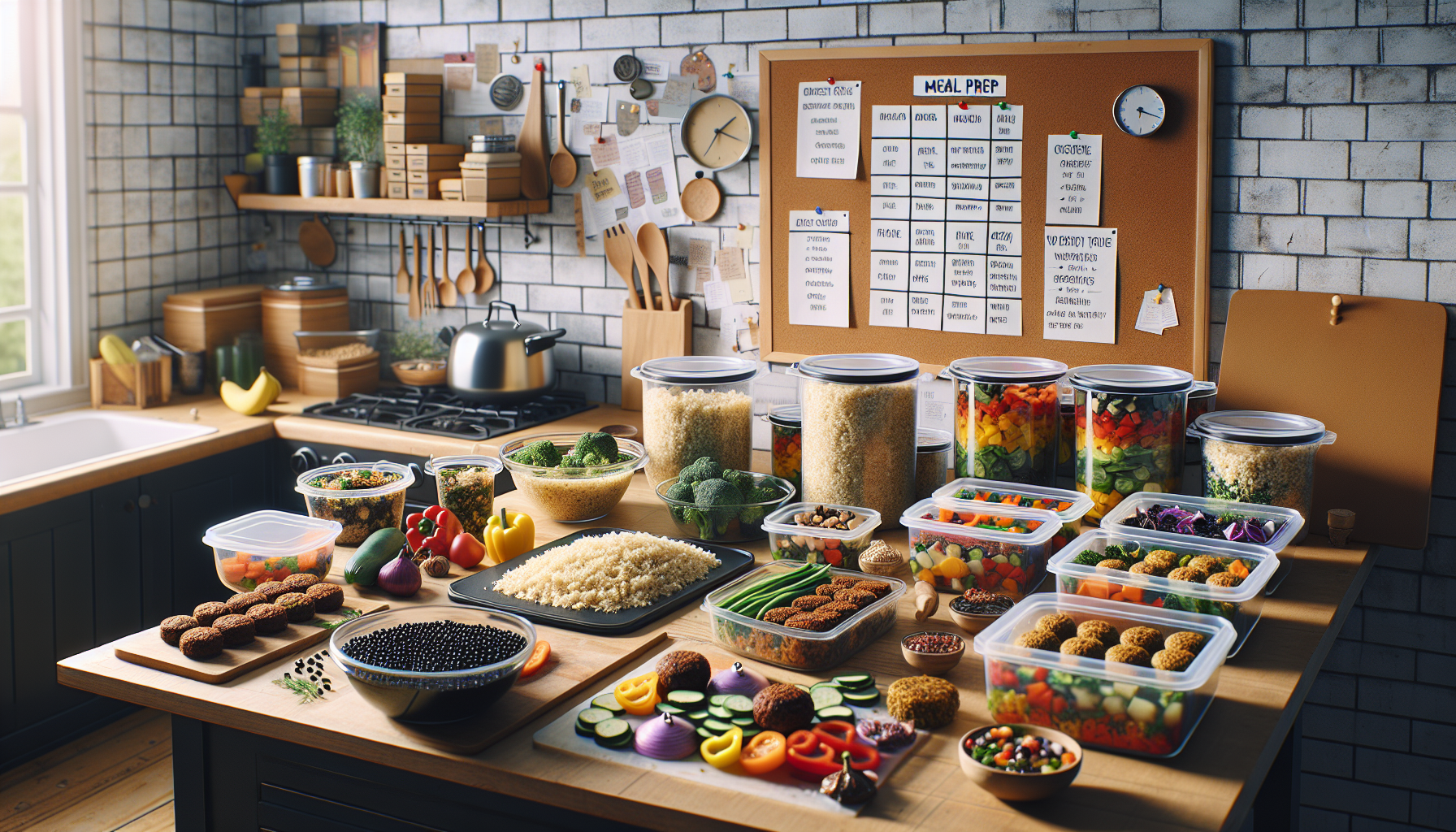Diving into the world of balanced meal prep and macronutrients offers a transformative approach to how we view, prepare, and consume food. This course is designed to navigate you through the essentials of understanding, calculating, and applying knowledge about macronutrients within your daily meal prep. From learning about the roles and sources of carbohydrates, proteins, and fats to tailoring your diet to your personal health goals, this course lays down the foundation for a healthier, more informed approach to eating. Whether you’re a fitness enthusiast looking to optimize your diet, someone interested in meal planning, or simply striving for a well-rounded diet, mastering the art of meal prep while balancing macronutrients will empower you to make smarter, more nourishing food choices every day.
Lesson 1

Understanding the Fundamentals of Macronutrients
Embarking on a journey to better health and wellness begins with a solid understanding of macronutrients. These essential building blocks of our diet play crucial roles in the functioning of our body. In this article, we dive deep into what macronutrients are and why they are indispensable for maintaining a healthy lifestyle. Let’s explore the pivotal role of carbohydrates, proteins, and fats, and how incorporating high-quality sources of these macronutrients into your diet can significantly enhance your health and wellness.
Introduction to Macronutrients
Macronutrients are nutrients that our bodies require in large amounts to generate energy and support bodily functions. The main macronutrients include carbohydrates, proteins, and fats, each serving unique and vital roles. Understanding the importance of these macronutrients is the first step towards achieving a balanced and nutritious diet.
The Role and Importance of Each Macronutrient
- Carbohydrates: They are the primary source of energy for the body. Quality matters, so focusing on high-fiber, whole-grain options can provide lasting energy and support digestive health.
- Proteins: Essential for building and repairing tissues, proteins also play a key role in immune function. Lean meats, legumes, and dairy are excellent protein sources.
- Fats: Despite their bad reputation, fats are essential for nutrient absorption, nerve transmission, and maintaining cell integrity. Opting for unsaturated fats like those found in avocados, nuts, and olive oil is beneficial for health.
Identifying High-Quality Sources of Macronutrients
Choosing high-quality sources for your macronutrients can dramatically affect your health. whole foods, unprocessed and rich in nutrients, should be the cornerstone of your diet. Here’s a simple guideline to follow:
| Macronutrient | High-Quality Sources |
|---|---|
| Carbohydrates | Whole grains, fruits, vegetables, legumes |
| Proteins | Lean meats, fish, dairy, legumes |
| Fats | Avocados, nuts, seeds, olive oil |
In conclusion, understanding and incorporating the right balance of macronutrients into your diet is pivotal in achieving a healthier lifestyle. By focusing on high-quality sources of carbohydrates, proteins, and fats, you will not only fuel your body sufficiently but also support its overall wellness and function. Remember, a balanced diet enriched with these essential macronutrients can pave the way for improved health and vitality.
Lesson 2

Calculating Your Macronutrient Needs for a Balanced Meal Plan
Knowing how to calculate your macronutrient needs is a game-changer in crafting a meal plan that aligns with your fitness and health goals. This guide will illuminate the path to understanding your body’s demand for macronutrients, ensuring you’re well-equipped to fuel your body optimally. Embarking on this journey allows you to tailor your meal prep endeavors to meet your unique dietary requirements, enhancing your wellness and vitality.
Understanding Basal Metabolic Rate and Total Daily Energy Expenditure
To kickstart your macronutrient calculation, you must first grasp the essence of Basal Metabolic Rate (BMR) and Total Daily Energy Expenditure (TDEE). Your BMR reflects the number of calories your body needs at rest to maintain vital functions, such as breathing and circulation. Conversely, TDEE incorporates your daily activities, offering a comprehensive calorie requirement snapshot. Together, these metrics serve as the cornerstone for your macronutrient calculations, ensuring your diet is finely tuned to support your lifestyle and objectives.
Setting Your Personal Health and Fitness Goals
Before diving into the numbers, take a moment to reflect on your objectives. Are you aiming for Weight loss, muscle gain, or perhaps maintaining your current physique? Your goals heavily influence your macronutrient ratios, underscoring the importance of clarity in this preliminary stage. Whether your focus is shedding pounds or bolstering muscle mass, determining your aim sets the stage for a tailored Nutrition plan that resonates with your aspirations.
Macronutrient Ratios for Your Goals
- Weight Loss: A higher ratio of proteins to carbohydrates can aid in satiety and lean muscle maintenance during calorie deficits.
- Muscle Gain: An increased intake of proteins and carbohydrates supports muscle repair and growth, especially when coupled with strength training.
- Maintenance: A balanced approach to macronutrients suits those aiming to maintain their current weight and composition.
Calculating Your Individual Macronutrient Needs
Armed with knowledge of your BMR, TDEE, and personal goals, it’s time to determine your precise macronutrient needs. This crucial step ensures your meal plans are not only satisfying but also aligned with your health and fitness journey. Consider utilizing online calculators and formulas tailored to macronutrient calculation for accuracy. Remember, these numbers are a starting point, and it’s essential to listen to your body and adjust as needed to meet its changing demands.
| Goal | Protein | Carbohydrates | Fats |
|---|---|---|---|
| Weight Loss | 40% | 30% | 30% |
| Muscle Gain | 30% | 40% | 30% |
| Maintenance | 30% | 30% | 40% |
Empowering yourself with the knowledge to calculate your macronutrient needs catapults you toward achieving your health and fitness ambitions. This guide not only simplifies the process but also ensures that your meal planning is a breeze, tailored to your own unique lifestyle and goals. With this wisdom, you’re well on your way to optimizing your meal prep and embracing a balanced, fulfilling approach to nutrition and wellness.
Lesson 3

Mastering Meal Prep Strategies for Balanced Macronutrients
Adopting a meal prep strategy that ensures a balanced intake of macronutrients is key to sustaining a healthy lifestyle and achieving your fitness goals. This comprehensive guide walks you through the steps to plan and prepare your meals with an eye towards the ideal balance of carbohydrates, proteins, and fats. By the end of this article, you’ll be equipped with the know-how to create a meal prep routine that not only caters to your nutritional needs but also fits seamlessly into your busy schedule.
Meal Planning Basics
The foundation of successful meal prep lies in effective planning. Start by selecting a variety of foods across all macronutrient groups to ensure nutritional diversity. Incorporating a mix of vegetables, lean proteins, whole grains, and healthy fats into your weekly menu can prevent boredom and promote better health. Furthermore, understanding portion sizes helps in creating balanced meals that satisfy without overeating.
Time-Saving Meal Prep Tips
- Allocate a specific day for meal prep to streamline the process and save time during the week.
- Invest in quality food storage containers to keep your meals fresh and portable.
- Batch cook staple items like grains and proteins to mix and match throughout the week.
Creating a Flexible Meal Prep Plan
A flexible meal prep plan accommodates changing schedules and preferences, making it easier to stick to your nutritional goals. One approach is to prepare a variety of base ingredients that can be combined in different ways to create unique meals on the fly. This strategy not only adds variety but also ensures that your diet remains balanced and interesting.
| Macronutrient | Meal Ideas |
|---|---|
| Carbohydrates | Quinoa salad, Sweet potato mash, Brown rice stir-fry |
| Proteins | Grilled chicken breast, Tofu scramble, Lentil soup |
| Fats | Avocado toast, Almonds and seeds, Olive oil dressing |
Embracing meal prep as part of your routine is a transformative step towards nurturing your body with the right balance of macronutrients. With the strategies outlined in this guide, you’re well on your way to simplifying your meal prep process while ensuring your meals are nutritious, balanced, and aligned with your health objectives. Remember, the goal is to create a sustainable plan that supports your wellness journey and fits your lifestyle, so feel free to adjust and customize as you go along.
Balancing macronutrients within your meal prep is an essential skill for crafting a nutritious diet that supports your health and fitness goals. This course equipped you with the knowledge to understand, calculate, and apply the roles of carbohydrates, proteins, and fats in your daily meals. By embracing these principles, you are now on the path to making informed and healthy food choices. To ensure you’ve fully grasped the concepts covered, a 10-question quiz awaits below this conclusion, designed to test your knowledge and solidify your understanding of balanced meal prep and macronutrient management.
Test Your Knowledge With this short Quiz
Click here to copy your score to share on facebook!







